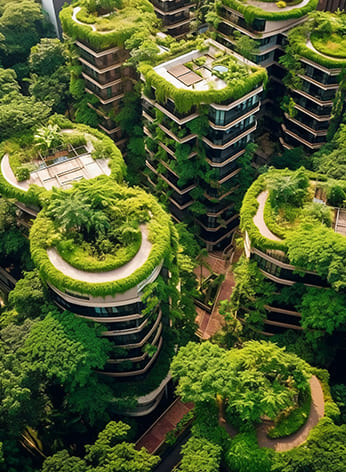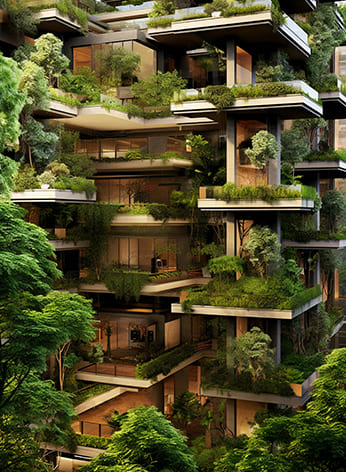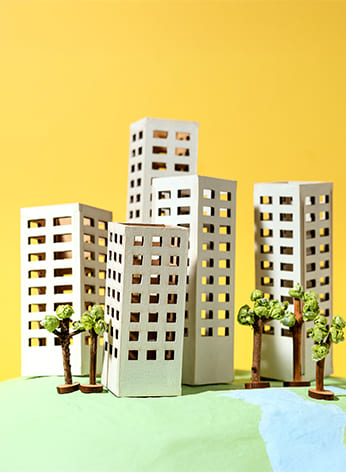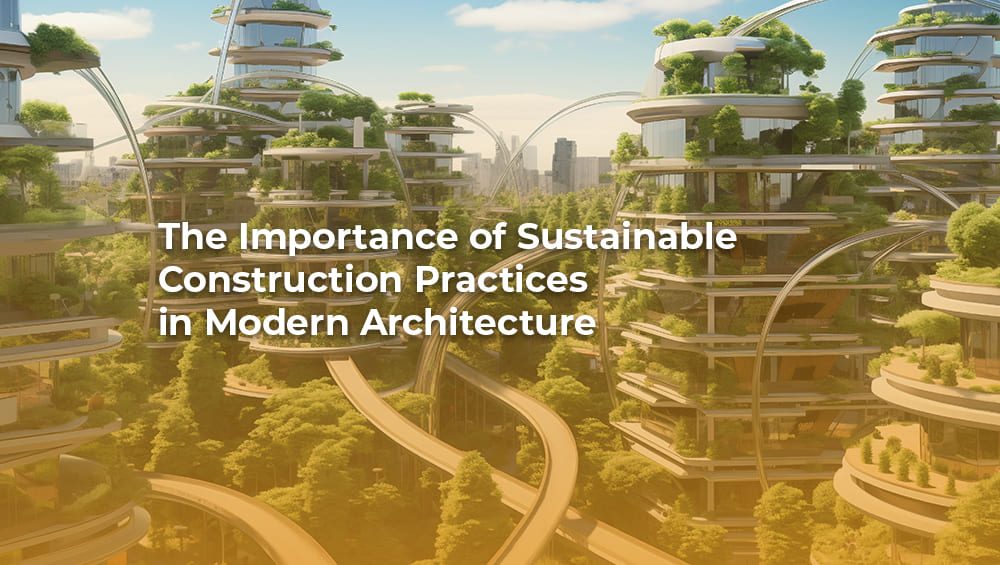Over the last few decades, there has been a prominent transition within the construction industry to a more sustainable construction. With increased demand for housing and infrastructural development on a global scale, buildings for very many housing facilities and related infrastructures are now being designed and built using ‘green’ concepts. This transformation isn’t just a trend but a necessity as modern architecture seeks to address the pressing issues of climate change, resource depletion, and energy inefficiency. The integration of green building practices has become a crucial element of designing and constructing structures that are both functional and ecofriendly.
One of the primary considerations in sustainable construction is the application of green materials. Generally, these materials are obtained from either a renewable or recycled resource, meaning that their use helps to lessen the impact on the environment as well as enhances the durability and energy efficiency of buildings. With an increasing demand for environment friendly structures, architects are able to incorporate materials that support energy savings and resource preservation along with enhancing the indoor air quality. It is not only the materials which are changing but the processes and ways of building are changing to more ecological way.
The use of resources efficiently constructed buildings has now become an essential part of contemporary architecture. Since construction and occupancy of buildings account for a large share of worldwide energy consumption, enhancing energy performance helps in lessening the greenhouse gas emissions. This shift in modern day construction is the trend of evolving technologies and design concepts which are actively creating low energy high performance emission buildings where green living is embraced.

The Evolution of Sustainable Construction
The concept of sustainable construction is not new, but its adoption has accelerated in recent decades. Historically, construction practices were largely resource intensive, relying on nonrenewable materials and energy sources. However, with the growing awareness of environmental degradation and the finite nature of these resources, there has been a paradigm shift towards more sustainable practices. Green building practices, once considered niche, are now becoming mainstream, driven by both regulatory demands and consumer expectations.
Architects and developers today are more inclined to adopt ecofriendly materials, such as bamboo, recycled steel, and low impact concrete. These materials not only reduce the strain on natural resources but also promote the reuse and recycling of existing materials, thereby contributing to a circular economy. The shift towards sustainability is not merely a response to environmental concerns but also an opportunity for innovation. New technologies and materials are constantly being developed to meet the demand for greener, more efficient buildings.
Apart from issues like resources the design of buildings has also advanced with regard to energy saving construction techniques. Passive solar design, high performance insulation and energy efficient windows are some of the ways in which consumption of energy can be controlled in modern buildings. Furthermore, as the construction industry has also embraced the use of these systems, more and more buildings come equipped with other renewable sources of energy such as solar panels and wind turbines. These innovations mitigate the ecological effects of structures and economically benefit the owners and occupants in the long run.

The Role of Modern Architecture Trends in Promoting Sustainability
Modern architecture trends have played a pivotal role in promoting sustainable construction practices. As urban populations grow, the demand for sustainable, energy efficient buildings has become more pressing. Today’s architects are tasked with creating structures that are not only aesthetically pleasing but also environmentally responsible. This requires a delicate balance between form and function, ensuring that buildings meet the needs of occupants while minimizing their ecological footprint.
One of the key trends in modern architecture is the emphasis on biophilic design, which seeks to incorporate natural elements into the built environment. By integrating features such as green roofs, vertical gardens, and natural lighting, architects can create spaces that not only reduce energy consumption but also improve the well being of occupants. These design elements not only enhance the visual appeal of buildings but also contribute to a healthier, more sustainable urban environment.
Another significant trend is the use of smart technologies to improve building efficiency. Smart building systems, which can monitor and adjust energy use in real time, have become a crucial component of energy efficient construction. These technologies enable buildings to operate more efficiently, reducing both energy consumption and costs. Additionally, the use of sensors and automation systems allows for better control of heating, cooling, and lighting, further enhancing the sustainability of modern buildings.
The Impact of Ecofriendly Materials on Construction
The use of ecofriendly materials is one of the most important aspects of sustainable construction. These materials are often derived from renewable resources or recycled products, making them less harmful to the environment compared to traditional materials. For example, bamboo, a rapidly renewable material, has become a popular alternative to conventional hardwood. Similarly, recycled steel and concrete are increasingly used in construction projects, reducing the need for new raw materials and decreasing the overall carbon footprint of buildings.
Ecofriendly materials not only reduce environmental impact but also contribute to the overall energy efficiency of a building. Many of these materials, such as low VOC (volatile organic compounds) paints and insulation made from recycled materials, can improve indoor air quality, making buildings healthier for occupants. Moreover, materials like reclaimed wood and recycled glass can add a unique aesthetic to buildings, combining sustainability with style.
Besides helping the ecosystem, purchasing green building materials will be cheaper in the long run. For instance, green buildings are made using building materials that do not wear out easily and do not need much repair within a short period of time. In addition, such materials fit well in buildings improving their energy efficiency, thus bringing down costs incurred for utilities and lessening the climate impact of the building as well. Essentially, the use of environmentally friendly construction materials has now become an important aspect to consider in the design and construction work of present times.
Energy Efficient Construction: A Pathway to Sustainability
The integration of energy efficient construction practices is essential for reducing the environmental impact of buildings. With the construction sector accounting for a large portion of global energy use, it is crucial to adopt strategies that minimize energy consumption. One of the most effective ways to achieve this is through passive design techniques, which take advantage of natural elements like sunlight and wind to regulate indoor temperatures.
Passive solar design, for instance, allows buildings to capture and store solar energy during the day, reducing the need for artificial heating. Similarly, high performance insulation and energy efficient windows help to maintain comfortable indoor temperatures without excessive energy use. By incorporating these elements into building design, architects can significantly reduce the energy demand of a structure.
In addition to passive design, the use of renewable energy sources is another important aspect of energy efficient construction. Solar panels, wind turbines, and geothermal systems can provide clean, renewable energy to buildings, further reducing their reliance on fossil fuels. These technologies not only lower energy costs but also contribute to the overall sustainability of the construction industry.

The Future of Sustainable Construction in Modern Architecture
As modern architecture continues to evolve, the importance of sustainable construction will only grow. With the global population expected to reach 9.7 billion by 2050, the need for sustainable, energy efficient buildings will become even more critical. Architects and developers will need to adopt innovative design strategies and technologies to meet the increasing demand for environmentally responsible structures.
One of the key drivers of this shift is the growing awareness of the environmental impact of construction. Governments and regulatory bodies around the world are implementing stricter building codes and sustainability standards, encouraging the adoption of green building practices. These regulations are pushing the construction industry towards more sustainable practices, ensuring that future buildings are designed with the environment in mind.
To sum up, green building has ceased to be just a trend but rather an important feature of today’s construction. The use of biodegradable materials, low energy consuming building processes and green construction principles are imperative to designer’s creating structures that are usable, beautiful and environmentally friendly. As concerns about climate change and depletion of the planet’s resources heighten, the importance of green buildings construction to the future of architecture cannot be overemphasized. The building blocks of these changes and the technologies that enable them will be sustained and further improved towards a more sustainable and low energy consuming infrastructure.



